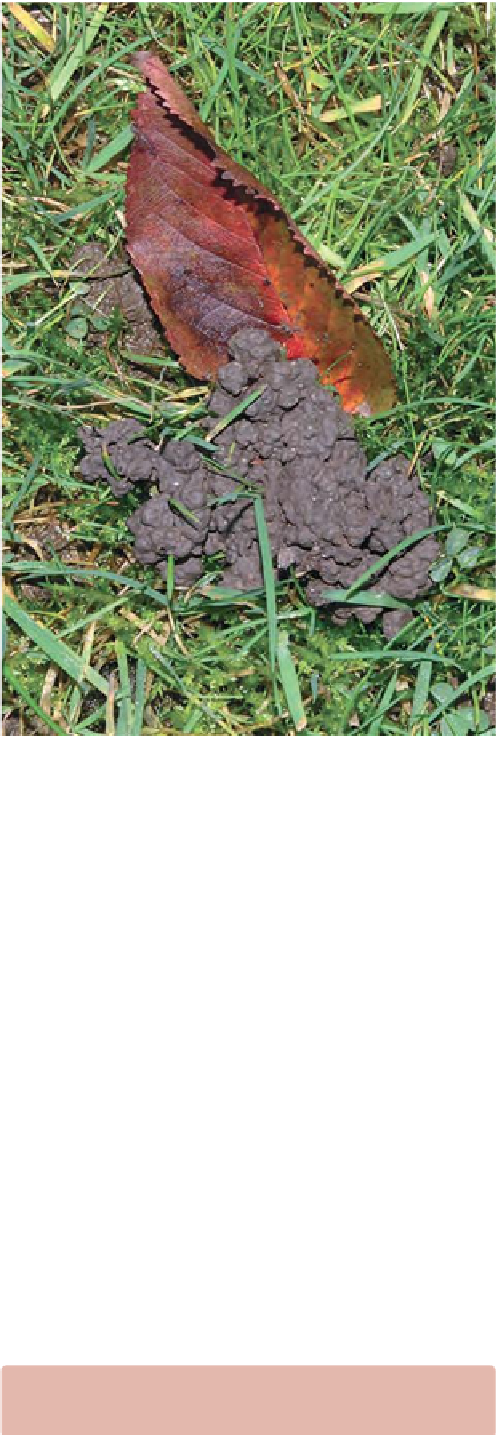Agriculture Reference
In-Depth Information
trees by bracket fungi, small insects by ants, roots
and fallen leaves by earthworms, mammal and bird
faeces by dung beetles, and so on. Subsequently,
progressively smaller organic particles are consumed
by millipedes, springtails, mites, nematodes
(eelworms), fungi and bacteria to leave, eventually,
just water, carbon dioxide, minerals (including plant
nutrients) and
humus
. This recycling process makes
available water, carbon dioxide and nutrients to a new
generation of plants. The production of plant nutrients
such as ammonia, nitrates, phosphates, potash and
sulphates from dead organic matter is sometimes
referred to as
mineralization
. Mineralization yields
nutrients that are readily taken up by plants from the
soil solution (see Chapter 14).
The type and
activity level of the living organisms
depends greatly on the food supply, organic matter
levels, but also water content, temperature, pH and air
(oxygen) levels. In general, decomposition is favoured
by aerobic, warm, moist and neutral conditions - for
example, earthworms are most active and abundant
in neutral, aerobic organic matter rich soils when
temperatures are about 10°C (i.e. spring and autumn).
In anaerobic (e.g. waterlogged), cold and/or very
acid areas there are fewer and completely different
organisms; decomposition is slower and the organic
matter is not fully broken down so it accumulates,
leading to the development of peaty soils or peat
bogs.
Earthworms
affect soil structure directly as they
create a network of burrows which significantly
improves aeration and water movement. This activity
is particularly important in uncultivated areas including
'no-dig' cultivation (see p. 150) and organic growing
(see p. 10). Many species feed on soil and digest the
organic matter in it before returning the waste into
the tunnel they have created. The crumbly nature
of this soil which is now an intimate mix of partially
digested organic matter and mineral matter is evident
from the worm casts left by one of the few species
that casts on the surface. Other species, including
those that are involved in composting, only eat organic
matter. Earthworms digest organic matter and play
an important part in incorporating leaf litter from the
surface; often dragging whole leaves underground
(see Figure 13.2).
Plant roots
also create tunnels that improve aeration
and water movement; they move soil as they
penetrate the soil and grow in size. Roots leave large
quantities of the organic matter in the soil profile.
When they die, the channels they have created are
stabilized by the coating of their decomposed remains.
Roots take up water and as the heavier soils dry out,
13
Figure 13.2
Earthworm cast on the surface, which is
a mix of organic matter and fi nely divided soil. Most
casts are left underground. Those on the surface can
be a problem on fi ne turf. Earthworms play a major
role in burying organic matter such as leaves
they shrink and crack thereby helping to develop
and improve their structure (see p. 147). A good
demonstration of the effect of abundant roots on soils
is seen under long-term grassland.
Bacteria
(see p. 262) are present in soils in vast
numbers. About 1000 million or more occur in each
gram of fertile soil. Consequently, despite their
microscopic size, the top 150 cm of fertile topsoil
carries about one tonne of bacteria per hectare. There
are many different species of bacteria to be found in
the soil and most play a part in the decomposition of
organic matter. This bacterial activity also affects soil
structure in so far as it leads to the release of nutrients
and hence more vigorous root growth as well as
by the creation of humus that improves soil crumb
development and stability.
Saprophytes
are organisms that live on dead
plant material.


